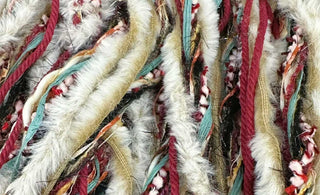
In the mysterious tapestry of Tibetan history, the accessories of the Zhang Zhung Empire emerge as ancient charms, whispering tales of opulence, spirituality, and cultural grandeur. Delve into the resplendent world of these artifacts, where each piece is a doorway to a bygone era.
I. The Enigmatic Tapestry Unveiled: Introduction to Zhang Zhung Elegance
As we embark on this journey of rediscovery, the Zhang Zhung Empire stands as the silent architect of Tibetan allure. Unveiling the enigmatic tapestry of its accessories, we unravel the threads of a civilization that sculpted beauty into every adornment.
II. Jewels of Spiritual Convergence: Sacred Amulets and Talismans
In the heart of Tibetan accessories lies a trove of sacred amulets and talismans, each encapsulating a spiritual resonance that transcends time. The "Gzi" beads, believed to possess protective energies, are coveted charms that speak of a deep connection between the earthly and the divine. These jewels were not mere ornaments but conduits for spiritual convergence, a testament to the spiritual wisdom woven into the fabric of Zhang Zhung adornments.
III. Radiance Beyond Metal: The Intricate Craftsmanship of Filigree Silverwork
The Zhang Zhung artisans elevated craftsmanship to a sublime art, particularly in the intricate filigree silverwork that graced their accessories. Like delicate lace spun from precious metals, these creations adorned the elite, reflecting not just affluence but an unparalleled dedication to detail. The silverwork was not merely an embellishment; it was a language of finesse, an expression of a society that understood the alchemy of turning metal into poetry.
IV. Gemstones as Time Capsules: Unveiling the Stories within Each Jewel
Embedded within the regal accessories were gemstones that transcended their material existence. Each gemstone was a time capsule, preserving stories of conquests, trade routes, and cultural exchanges. The turquoise, revered as a symbol of protection, adorned headdresses and bracelets, its vibrant hue echoing the expansive skies that watched over the nomadic tribes of Zhang Zhung.
V. Echoes of Royalty: Crowns and Diadems as Symbols of Power
In the opulent tapestry of regal significance, the majestic diadems and crowns that adorned the elite transcended mere ornate headpieces to emerge as profound symbols of power and authority. Woven into the very fabric of societal hierarchy, these regal accessories painted a vivid portrait where each meticulously placed gemstone and delicately crafted filigree strand served as a visual representation of one's position on the ladder of societal standing. Beyond their dazzling aesthetics, these crowns were not mere fashion statements; rather, they were the emphatic exclamation points punctuating a civilization's fervent celebration of its rulers in a spectacle of resplendent glory.
Among the treasures of this regal ensemble, a particular artifact, the "Khyung Ngonpo Talisman Pendant Tibetan Thokcha," emerges as a mystical revelation, intertwining its narrative with the broader tapestry of authority. Suspended from regal necklaces or nestled within the folds of royal garments, this talisman transcends the boundaries of mere ornamentation. With its meticulous craftsmanship and adorned with ancient symbols, the thokcha becomes a microcosm of the grandeur found in the crowns and diadems. It encapsulates not only the tangible allure of gem-studded splendor but also the intangible mystique of spiritual resonance, protection, and wisdom that it is believed to bestow upon its wearer.
As we delve into the profound symbolism embedded in these regal adornments, we uncover a narrative that extends beyond the realm of fashion into the very essence of societal dynamics. The filigree strands and gemstones are not arbitrary embellishments but rather a coded language that communicates one's societal standing. Each gem, chosen with precision for its color, rarity, and metaphysical significance, weaves a tale of prestige and power. The crowns, standing as tangible manifestations of this symbolism, collectively embody a communal celebration of leadership—a testament to a civilization's collective awe and admiration for its rulers.
The Khyung Ngonpo Talisman Pendant, with its intricate design and ancient symbolism, serves as a bridge between the tangible and the mystical, offering a glimpse into the spiritual dimensions that coexisted with the earthly authority represented by the crowns and diadems. Its compact form becomes a potent emblem of the regal mystique, encapsulating the enduring echoes of royalty that persist across temporal boundaries. As we traverse the corridors of time, these artifacts remain not as relics of a bygone era but as portals inviting us to explore the cultural, spiritual, and hierarchical intricacies of ancient Tibetan society—a society that understood the language of adornment and the profound significance of each embellishment in the grand narrative of power and prestige.
VI. Legacy in Textiles: Embroidered Elegance of Zhang Zhung Garments
Beyond the shimmering metals and gleaming gemstones, the Zhang Zhung legacy also resides in the intricate embroidery of garments. Silk threads, vibrant and rich, wove tales of landscapes, deities, and historical events into the very fabric of clothing. These weren't mere garments; they were narratives, walking canvases that depicted the cultural ethos of a people.
VII. The Twilight of Zhang Zhung: A Eulogy to Ephemeral Elegance
As we conclude this odyssey through the treasures of the Zhang Zhung Empire, we encounter the poignant reality of its twilight. The fall of empires may dim the radiance of their accessories, but in their antiquity, they find a new kind of allure. The echoes of Zhang Zhung resonate not just through jewelry and garments but in the very essence of Tibetan aesthetics, an eternal charm that refuses to be forgotten.
In the rediscovery of Tibetan accessories from the Zhang Zhung Empire, we unearth not just artifacts but fragments of a lost symphony, a melody that still hums in the windswept plateaus and resonates in the hearts of those who seek to unravel the mysteries of ancient charms.
























